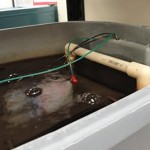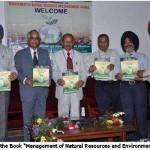Marseille (France) / Nairobi (Kenya) – Recognizing the valuable services provided by ecosystems such as wetlands and forests – and not only focusing on water productivity in agriculture – can improve livelihoods and help meet the rising demands on the world’s water resources in a sustainable way, according to a new report from the United Nations Environment Programme (UNEP).
Increasing water productivity and efficiency is a key concern for policymakers in many parts of the world, especially as rising incomes and changing diets are set to increase the demand on water resources that are already under pressure.

The UNEP report, entitled “Releasing the Pressure: Water Resource Efficiencies and Gains for Ecosystem Services”, which was produced by researchers at the Stockholm Environment Institute (SEI), urges policymakers and resource managers to shift from the traditional focus on water productivity per unit of agricultural yield (“more per crop drop”), to a broader view of the concept, which would include ecosystems services.
Such an approach would take into account water regulation and purification, pollination, erosion control and other ecosystems services performed by wetlands and forests. These water-dependent services, and the communities that rely on them, can be adversely affected when water is siphoned off from rivers or streams, or drained from marshes, for agricultural use.
Balancing the goals of agricultural land (agro-ecosystems) with these kinds of ecosystem services – using some of the techniques outlined in the UNEP report – can serve to improve human well-being, increase crop yields in a sustainable way and support the transition to a low-carbon, resource-efficient and equitable Green Economy.
“Assessing water productivity narrowly – for example, by simply looking at crop, fodder and forest produce – will continue to under-value the role of water for wider society and the economy,” said UN Under-Secretary-General and UNEP Executive Director Achim Steiner.
“Recognizing the wider benefits generated by water, for example nutrient flows, cooling, providing habitats, and other supporting and regulating ecosystem services, is the aim of our work. Water may soon be a critically restricted resource for a growing number of people. In just over three months, world governments will meet for the UN Conference on Sustainable Development (Rio+20). This report addresses an important issue for future sustainable development: how to enhance the productive and equitable use of water for multiple needs,” added Mr Steiner.
Using Existing Techniques to Improve Water Productivity
The report uses case studies from Africa and Asia to demonstrate how some of the pressure on limited water resources can be managed with existing techniques – in a way that benefits both agro-ecosystems and ‘downstream’ ecosystem services.
Improving the productivity of water used in rain-fed agriculture in Africa, Eastern Europe and Central Asia – which provides 60 per cent of the world’s cereal crops – is an untapped opportunity to meet food, fodder and fibre demands, says the study.
Soil and water conservation, minimum tillage and rainwater harvesting are techniques that can close the gap between actual and potential yields of crops in a sustainable way. Closing current yield gaps to within 95 per cent of potential yields in rain-fed agriculture could increase grain production by 58 percent, while maintaining current levels of water use. Importantly, this allows water flows in the surrounding landscape to continue to sustain ecosystems services.
A case study from the report of an ecosystems evaluation in the Barotse floodplain, Zambia, shows that more than three-quarters of household income there comes from subsistence activities supported by ecosystem services, such as fishing and livestock grazing.
The report also shows how agricultural water management interventions have made both positive and negative impacts on water outflows, sediment transport and soil loss in the Kothapally watershed, in southern India.
“A narrow definition of ‘water productivity’ considers only the value of agricultural produce, but doesn’t put a price on lost drinking water, reduced fish populations, parched pastures, or shrinking groundwater reservoirs,” said Jennie Barron, a research fellow at SEI’s centre at the University of York, U.K., who wrote the report with SEI-U.S. researcher Patrick Keys, based in Seattle, Washington.
“Improving water management to reflect multiple needs and multiple uses is crucial to sustaining water’s many benefits to human well-being, societies and economies,” said Keys.
“Many ecosystem services that underlie people’s livelihoods draw on the same water resources used for agriculture: wetlands that provide reeds, fish and rice; forests that supply timber, firewood and game. In addition, water is needed to support and regulate important functions such as nutrient transport, vapour flow and sediment flow,” he added.
The report aims to encourage water and land resource managers around the world to explore the ecosystem service gains and tradeoffs in their own local contexts, such as watersheds, landscapes, countries, or basins.














